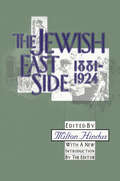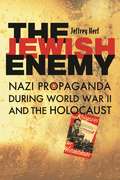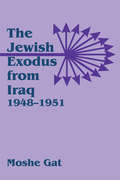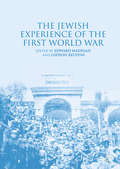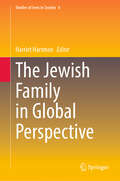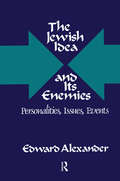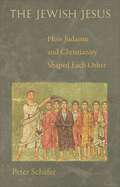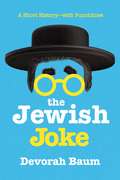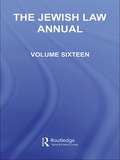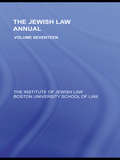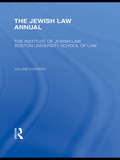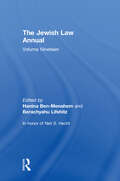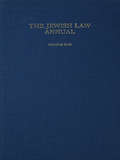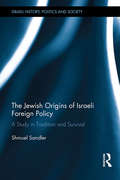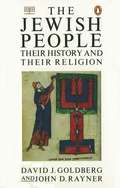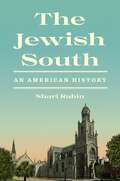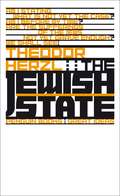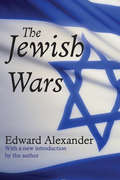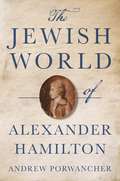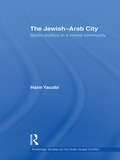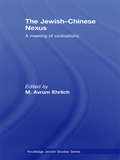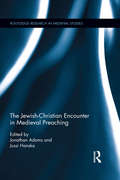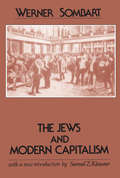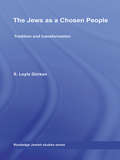- Table View
- List View
The Jewish East Side: 1881-1924 (The Library of Conservative Thought)
by Milton HindusThis book, originally published as The Old East Side, is a collection of literature and documents ranging from the autobiography of the sculptor Jacob Epstein and the novels of Abraham Cahan to the reporting of William Dean Howells and the fictional reconstruction of a vanished world by Henry Roth. The world is that of the old shtetl transplanted to a new, growing country, where "the ghetto" (in the years 1881-1924) was an unstable mixture of nostalgic elements and the pressures of American economic and social reality.The productivity, both intellectual and material, of the section of New York known as the East Side during those forty years around the turn of the twentieth century has become a legend among many Jews in this country and deserves to become better known to many more of other ethnic origins. The lower East Side was paradoxically a wilderness to be traversed and a portion of that "promised land" which had been glimpsed with so much hope from afar. To wonderfully talented and observant children, like Jacob Epstein, the streets there in the 1880s were as filled with excitement as those of the Arabian Nights. To serious philosophic young men like Morris Raphael Cohen, they were as challenging as the marketplace of Athens had once been to Socrates to achieve intellectual enlightenment and the improvement of the social order.The conditions of abominable crowding and poverty described in the sociological tracts of Jacob Riis, Lillian Wald, and others are better known perhaps to the average reader than the accounts of such pleasures as the dancing schools, the Yiddish theaters, the cafes, the lectures, the literary ferment and activities, described in the pages of Abraham Cahan and Hutchins Hapgood. But all the views presented in The Jewish East Side, both dark and bright, are recognizably parts of the same picture. This book will be of value to sociologists, historians, researchers specializing in Judaic studies, and students of literature.
The Jewish Enemy: Nazi Propaganda during World War II and the Holocaust
by Jeffrey Herf<p>The sheer magnitude of the Holocaust has commanded our attention for the past sixty years. The extent of atrocities, however, has overshadowed the calculus Nazis used to justify their deeds. <p>According to German wartime media, it was German citizens who were targeted for extinction by a vast international conspiracy. Leading the assault was an insidious, belligerent Jewish clique, so crafty and powerful that it managed to manipulate the actions of Roosevelt, Churchill, and Stalin. Hitler portrayed the Holocaust as a defensive act, a necessary move to destroy the Jews before they destroyed Germany. <p>Joseph Goebbels, Minister of Propaganda, and Otto Dietrich’s Press Office translated this fanatical vision into a coherent cautionary narrative, which the Nazi propaganda machine disseminated into the recesses of everyday life. Calling on impressive archival research, Jeffrey Herf recreates the wall posters that Germans saw while waiting for the streetcar, the radio speeches they heard at home or on the street, the headlines that blared from newsstands. The Jewish Enemy is the first extensive study of how anti-Semitism pervaded and shaped Nazi propaganda during World War II and the Holocaust, and how it pulled together the diverse elements of a delusionary Nazi worldview. Here we find an original and haunting exposition of the ways in which Hitler legitimized war and genocide to his own people, as necessary to destroy an allegedly omnipotent Jewish foe. In an era when both anti-Semitism and conspiracy theories continue to influence world politics, Herf offers a timely reminder of their dangers along with a fresh interpretation of the paranoia underlying the ideology of the Third Reich.</p>
The Jewish Exodus from Iraq, 1948-1951
by Moshe GatIn this study, Moshe Gat details how the immigration of the Jews from Iraq in effect marked the eradication of one of the oldest and most deeply-rooted Diaspora communities. He provides a background to these events and argues that both Iraqi discrimination and the actions of the Zionist underground in previous years played a part in the flight. The Denaturalization law of 1950 saw tens of thousands of Jews registering for emigration, and a bomb thrown at a synagogue in 1951 accelerated the exodus.
The Jewish Experience of the First World War
by Edward Madigan Gideon ReuveniThis book explores the variety of social and political phenomena that combined to the make the First World War a key turning point in the Jewish experience of the twentieth century. Just decades after the experience of intense persecution and struggle for recognition that marked the end of the nineteenth century, Jewish men and women across the globe found themselves drawn into a conflict of unprecedented violence and destruction. The frenzied military, social, and cultural mobilisation of European societies between 1914 and 1918, along with the outbreak of revolution in Russia and the collapse of the Ottoman Empire in the Middle East had a profound impact on Jewish communities worldwide. The First World War thus constitutes a seminal but surprisingly under-researched moment in the evolution of modern Jewish history. The essays gathered together in this ground-breaking volume explore the ways in which Jewish communities across Europe and the wider world experienced, interpreted and remembered the ‘war to end all wars’.
The Jewish Family in Global Perspective (Studies of Jews in Society #6)
by Harriet HartmanThis book contains a collection of chapters about the Jewish family across different parts of the world, with contributions representing Africa (Ivory Coast and Ethiopia), Latin America, Australia, Europe (Germany), Russia, Israel, Canada, Indian families in Canada, and a comparative chapter of Ba’a lot Teshuva in the US and Argentina. Where much existing research and literature on the dynamic process of intermarriage and (Jewish) family life has taken primarily a historical approach, here the authors together present a broad, global, comparative approach.The book uses an open systems model to organize comparisons between Jewish families the world over. Each case study focuses on Jewish family life in a particular country or region of the world and, taken together, cover an extensive range of topics – including but not limited to: demographic and socio-economic description of the Jewish families; immigration patterns; family roles; family engagement in Jewish life; marriage formation; interfaith families; same-sex couples/parenting – surveying the extant research and/or reporting on new research about contemporary families, within the historical context. The book therefore presents a novel framework for understanding the variations in Jewish families to highlight what Jewish families the world over have in common (whether within the microsystem of the family or in the family’s relationships with the environment), as well as using the open systems model to explain main types of difference between the various regions.
The Jewish Idea and Its Enemies: Personalities, Issues, Events
by Hadley Cantril Edward AlexanderThis volume deals with the modern fate of the traditional conception of Jews as a covenanted people chosen to receive the Law, whose ultimate purpose is contributing to the universal salvation of mankind. The author shows how, under the influence of liberalism, rationalism, relativism, and other Enlightenment ideologies, this idea was distorted, denied, inverted, yet never entirely obliterated. In his discussions of modern Jewish thinkers and writers and the ideological and political struggles of Zionism and the state of Israel against enemies from without and from within, Alexander shows that the ancient idea of covenant is still alive today, if only in the assumption that Jewish life can lead somewhere so long as Jews remember that it began somewhere. Ranging from literary criticism and the history of ideas to journalism and politics, the book is unified by a point of view unabashedly espousing the Jewish idea and challenging its enemies.
The Jewish Jesus: How Judaism and Christianity Shaped Each Other
by Peter SchäferHow the rise of Christianity profoundly influenced the development of Judaism in late antiquityIn late antiquity, as Christianity emerged from Judaism, it was not only the new religion that was being influenced by the old. The rise and revolutionary challenge of Christianity also had a profound influence on rabbinic Judaism, which was itself just emerging and, like Christianity, trying to shape its own identity. In The Jewish Jesus, Peter Schäfer reveals the crucial ways in which various Jewish heresies, including Christianity, affected the development of rabbinic Judaism. He even shows that some of the ideas that the rabbis appropriated from Christianity were actually reappropriated Jewish ideas. The result is a demonstration of the deep mutual influence between the sister religions, one that calls into question hard and fast distinctions between orthodoxy and heresy, and even Judaism and Christianity, during the first centuries CE.
The Jewish Joke: A Short History--with Punchlines
by Devorah BaumHeard the one about the Rabbi and the cow from Minsk? Look no further than this witty compendium, a fascinating and revealing celebration of the great Jewish Joke. Comedy is full of famously funny Jews, from Groucho Marx to Sarah Silverman, from Larry David to Jerry Seinfeld. This smart and funny book includes tales from many of these much-loved comics, and will appeal to their broad audience, while revealing the history, context and wider culture of Jewish joking. The Jewish joke is as old as Abraham, and like the Jews themselves it has wandered over the world, learned countless new languages, worked with a range of different materials, been performed in front of some pretty hostile crowds, and yet still retained its own distinctive identity. So what is it that animates the Jewish joke? Why are Jews so often thought of as ‘funny’? And how old can a joke get? The Jewish Joke is a brilliant—and laugh-out-loud funny—riff on about what marks Jewish jokes apart from other jokes, why they are important to Jewish identity and how they work. Ranging from self-deprecation to anti-Semitism, politics to sex, Devorah Baum looks at the history of Jewish joking and asks whether the Jewish joke has a future. With jokes from Lena Dunham to Woody Allen, as well as Freud and Marx (Groucho, mostly), Baum balances serious research with light-hearted humor and provides fascinating insight into this well-known and much loved cultural phenomenon.
The Jewish Law Annual Volume 16 (Jewish Law Annual #10)
by Berachyahu LifshitzVolume 16 of The Jewish Law Annual adds to the growing list of articles on Jewish Law that have been published in volumes 1-15 of this series, providing English-speaking readers with scholarly material meeting the highest academic standards. The volume contains seven articles diverse in their scope and focus, encompassing legal, historic, textual, comparitive and conceptual analysis, as well as a chronicle of cases of interest, and a survey of recent literature. Three of the articles, one of which explores references to Genesis in (western) canon law, make up a special section on the book of Genesis. The other topics covered are: suicide as an act of atonement in Jewish law; early interpretations of the Bible and Talmud as reflecting medieval legal realia; Ashkenazic codifiers in Spain; and authority, custom and innovation in the seventeenth-century Italian halakhic encyclopedia, Pahad Yitzhak.
The Jewish Law Annual Volume 17 (Jewish Law Annual)
by Berachyahu LifshitzVolume 17 of The Jewish Law Annual adds to the growing list of articles on Jewish law that have been published in volumes 1-16 of this series, providing English-speaking readers with scholarly articles presenting jurisprudential, historical, textual and comparative analysis of issues in Jewish law. The volume contains seven articles diverse in their scope and focus. Two articles are devoted to the halakhic thought of Rabbi A. I Kook; two treat classic legal questions: breach of a promise to marry, and the legal capacity of minors; two examine aspects of the judicial process, one exploring talmudic analyses of the biblical requirement that courts be established in every town, and the other, post-talmudic views on judicial authority in cases suspected of fraudulent claims. Another article addresses the fascinating question of the epistemic-pedagogic worldviews of the rival Tannaitic legal academics, the House of Hillel and the House of Shammai. The volume concludes with a section on Israeli legislation that adduces or is informed by Jewish law, and two reviews of a much-discussed recent book on a topic of considerable contemporary interest: the agunah problem.
The Jewish Law Annual Volume 18 (Jewish Law Annual #18)
by Berachyahu LifshitzVolume 18 of The Jewish Law Annual contains six comprehensive articles on various aspects of Jewish law. Three articles address family law. One addresses the painful issue of the plight of the wife whose husband withholds conjugal relations. In a marriage where relations are withheld, the wife may seek a divorce, while her husband may withhold divorce. Prolonged withholding of divorce renders the wife an agunah, that is, a wife chained to a dead marriage and unable to start anew and rebuild her life. The author explores the halakhic feasibility of allowing a wife in such a predicament to bring a claim for damages against her husband for infliction of mental distress. If such claims are allowed, recalcitrant husbands may rethink their intransigence and consent to grant the divorce. Another article examines the evolution of halakhic thinking on the parent–child relationship. It traces the stages by which halakhic family law changed from a basically patriarchal system in which both mother and the child were deemed subject to the father’s will, to a more balanced system where wife and husband have equal standing with respect to custody matters, and the best interest of the child is the main consideration in custody proceedings. In another article, halakhic attitudes to corporal punishment of children are analyzed. The author explores whether the "Spare the rod and spoil the child" adage, which is based on a verse from Proverbs, indeed reflects the position of Jewish law. He shows that in fact, while recourse to corporal punishment for educational purposes is permitted--subject to detailed qualifications that greatly limit its scope--two divergent approaches to corporal punishment can be discerned in the halakhic sources. One maintains that administration of corporal punishment can be a useful pedagogic tool of last resort, whereas the other seeks to minimize recourse to corporal punishment in the educational context, questioning its efficacy. The article shows that in any event, the notion that corporal punishment is required by the law, as some, invoking the "spare the rod" maxim, have maintained, is by no means borne out by the halakhic literature. The volume also features a fascinating article on the history of two societies founded in London to further the study of Jewish law using modern scholarly methodologies. One society was active at the end of the 1920s and beginning of the 1930s, the second was active a decade later. The article explains the background to the establishment of the societies and analyzes the societies’ objectives, leaders and memberships. Both societies were founded with the intention of reformulating the classic halakhic sources in a manner that would render them suitable for contemporary application in the nascent Jewish state. But as the author shows, ultimately much of their energy was devoted to presenting the said sources to the non-Jewish legal world, for the purpose of reciprocal enrichment and edification. Rounding out the volume are two jurisprudential studies on classic legal problems. The first explores the prohibition against seeking a second legal ruling when a ruling declaring something forbidden has been handed down. What is the scope of this rule, and in what ways does it differ from the res judicata principle in western law? The author shows that both procedural and substantive readings of the prohibition were put forward in the talmudic commentaries, and explains the jurisprudential implications of these different readings. The second article examines the question of the agent who breaches his principal’s trust, focusing on the case of the agent who executes the act he was sent to carry out, but does so for himself, rather than his principal. To what extent is he liable for ensuing damages to the principal, and is his act invariably deemed reprehensible? Another issue is the legal status of the transaction carried out by such an agent. Do the rights and obligations ge
The Jewish Law Annual Volume 19 (Jewish Law Annual #19)
by Berachyahu Lifshitz Hanina Ben-MenahemVolume 19 of The Jewish Law Annual is a festschrift in honor of Professor Neil S. Hecht. It contains thirteen articles, ten in English and three in Hebrew. Several articles are jurisprudential in nature, focusing on analysis of halakhic institutions and concepts. Elisha Ancselovits discusses the concept of the prosbul, asking whether it is correct to construe it as a legal fiction, as several scholars have asserted. He takes issue with this characterization of the prosbul, and with other scholarly readings of Tannaitic law in general. The concepts of dignity and shame are addressed in two very different articles, one by Nahum Rakover, and the other by Hanina Ben-Menahem. The former discusses halakhic sources pertaining to the dignity inherent in human existence, and the importance of nurturing it. The latter presents a fascinating survey of actual legal practices that contravened this haklakhic norm. Attestations of these practices are adduced not only from halakhic and semi-halakhic documents, but also from literary, historical, and ethnographic sources. Three articles tackle topical issues of considerable contemporary interest. Bernard S. Jackson comments on legal issues relating to the concept of conversion arising from the story of the biblical heroine Ruth, and compares that concept to the notion of conversion invoked by a recent English court decision on eligibility for admission to denominational schools. An article by Dov I. Frimer explores the much agonized-over question of halakhic remedies for the wife whose husband refuses to grant her a get (bill of divorce), precluding her remarriage. Frimer’s focus is the feasibility of inducing the husband to grant the get through monetary pressure, specifically, by awarding the chained wife compensatory tort damages. Tort remedies are also discussed in the third topical article, by Ronnie Warburg, on negligent misrepresentation by investment advisors. Two papers focus on theory of law. Shai Wozner explores the decision rules–conduct rules dichotomy in the Jewish law context, clarifying how analysis of which category a given law falls under enhances our understanding of the law’s intent. Daniel Sinclair explores the doctrine of normative transparency in the writings of Maimonides, the Hatam Sofer, and R. Abraham Isaac Kook, demonstrating that although transparency was universally endorsed as an ideal, some rabbinical authorities were willing to forego transparency where maintenance of the halakhic system itself was imperiled. An article by Alfredo M. Rabello reviews the primary and secondary literature on end-of-life issues, and contextualizes the much-discussed talmudic passage bAvoda Zara 18a. And an article by Chaim Saiman offers a critical survey of the main approaches to conceptualizing and teaching Jewish law in American universities; it also makes suggestions for new, and perhaps more illuminating pedagogic direction. In the Hebrew section, an intriguing article by Berachyahu Lifshitz presents a comparison of Persian and talmudic law on the status of promises and the role of the divine in their enforcement. Yuval Sinai discusses the halakhic law of evidence, particularly the well-known "two witnesses" requirement and departures from it. The volume closes with a historical article by Elimelech Westreich on the official rabbinical court in nineteenth century Jerusalem. It focuses on the rabbinical figures who served on the court, the communities for whom it adjudicated, and its role in the broader geopolitical and sociocultural context.
The Jewish Law Annual Volume 5 (Jewish Law Annual #5)
by Bernard S. JacksonVolume 15 of The Jewish Law Annual adds to the growing list of articles on Jewish law that have been published in volumes 1-14 of this series, providing English-speaking readers with scholarly material meeting the highest academic standards. The volume contains six articles diverse in their scope and focus, encompassing legal, historical, textual, comparative and conceptual analysis, as well as a survey of recent literature and a chronicle of cases of interest. Among the topics covered are: lying in rabbinical court proceedings; unjust enrichment; can a witness serve as judge in the same case?; Caro's Shulham Arukh v. Maimonides' Mishne Torah in the Yemenite community, the New Jersey eruv wards.
The Jewish Origins of Israeli Foreign Policy: A Study in Tradition and Survival (Israeli History, Politics and Society)
by Shmuel SandlerThe conventional understanding of Israeli foreign policy has been that it is a relatively new phenomenon, with some claiming that the ‘Jewish People’ is an invention by mid-19th century Jewish historians, or simply an ‘imagined community’. This book disputes these claims by demonstrating that the Jews have a tradition of foreign relations based on an historical political tradition that goes back thousands of years, and that this tradition has been carried over to the State of Israel. The Jewish political tradition in foreign policy has always been defensive-oriented, whether under sovereignty or in the Diaspora. Power has generally been only a means for achieving survival rather than a goal in itself, whereas Jewish national identity has always been related to historical Zion. In order to explore the question of whether it is possible to identify patterns of international behaviour in the foreign policy of the Jews, the book begins with the Bible and continues through the period of the First and Second Temples, then looks at the long generations when the Jewish people were stateless, and ultimately concludes with an examination of the sovereign Jewish state of Israel. The underlying assumption is that an understanding of these characteristics will allow us to derive a better understanding of the Jewish origins of Israel’s foreign policy, which should in turn help to eliminate many of the harshest criticisms of Israel’s foreign policy. By presenting a nuanced and intricate examination of longstanding Jewish foreign policy principles, this book will appeal to students and scholars of Jewish Studies, Israeli Studies, International Relations and anyone with an interest in the relationship between religion and foreign policy.
The Jewish People: Their History and Their Religion
by David Goldberg John RaynerThe first part of this illustrated volume offers a survey of Jewish history and literature. The second part presents what the preface describes as "a thematic analysis of the teachings and practice of Judaism".
The Jewish Revolution in Belorussia: Economy, Race, and Bolshevik Power (The Modern Jewish Experience)
by Andrew SloinA Dorothy Rosenberg Prize–winner: "A remarkable social history that investigates the process of Sovietization among Jews in Belorussia&” (Jeffrey Veidlinger, author of In the Shadow of the Shtetl). This insightful history demonstrates how Jewish life in Belorussia fundamentally changed when Jews started joining the Bolshevik movement and populating the front lines of the revolutionary struggle. While Andrew Sloin&’s story follows the arc of Bolshevik history, it also shows how the broader movement was enacted in factories and workshops, workers&’ clubs and union meetings, and on the Jewish streets of White Russia. In the eyes of the Bolshevik leadership, the project of transforming Jews into integrated Soviet citizens was bound inextricably to labor. The protagonists here are shoemakers, speculators, glassmakers, peddlers, leatherworkers, needleworkers, soldiers, students, and local party operatives who were swept up, willingly or otherwise, under the banner of Marxist socialism. With extensive research and keen insight, Sloin stresses the fundamental relationship between economy and identity formation as party officials grappled with the Jewish Question in the wake of the revolution.
The Jewish South: An American History
by Shari RabinA panoramic history of the Jewish American South, from European colonization to todayIn 1669, the Carolina colony issued the Fundamental Constitutions of Carolina, which offered freedom of worship to &“Jews, heathens, and other dissenters,&” ushering in an era that would see Jews settle in cities and towns throughout what would become the Confederate States. The Jewish South tells their stories, and those of their descendants and coreligionists who followed, providing the first narrative history of southern Jews.Drawing on a wealth of original archival findings spanning three centuries, Shari Rabin sheds new light on the complicated decisions that southern Jews made—as individuals, families, and communities—to fit into a society built on Native land and enslaved labor and to maintain forms of Jewish difference, often through religious innovation and adaptation. She paints a richly textured and sometimes troubling portrait of the period, exploring how southern Jews have been targets of antisemitism and violence but also complicit in racial injustice. Rabin considers Jewish immigration and institution building, participation in the Civil War, the 1915 lynching of Leo Frank, and Jewish support for and resistance to the modern fight for Black civil rights. She examines shifting understandings of Jewishness, highlighting both the reality of religious diversity and the ongoing role of Christianity in defining the region.Recovering a neglected facet of the American experience, The Jewish South enables readers to see the South through the eyes of people with a distinctive religious heritage and a southern history older than the United States itself.
The Jewish State (Penguin Great Ideas)
by Theodor Herzl'We shall live at last as free men on our own soil, and die peacefully in our own homes'Theodor Herzl's passionate advocacy of the founding of a Jewish state grew out of his conviction that Jews would never be assimilated into the populations in which they lived. Herzl concluded that the only solution for the majority of Jews would be organised emigration to a state of their own.Herzl's political and social plea was the result of centuries of restrictions, hostility and pogroms against the Jews of Europe. His revolutionary proposal for the solution to anti-Semitism was a Jewish state, where Jews could live in peace, free from persecution - and this hugely influential essay led directly to the creation of Israel.GREAT IDEAS. Throughout history, some books have changed the world. They have transformed the way we see ourselves - and each other. They have inspired debate, dissent, war and revolution. They have enlightened, outraged, provoked and comforted. They have enriched lives - and destroyed them. Now Penguin brings you the works of the great thinkers, pioneers, radicals and visionaries whose ideas shook civilization and helped make us who we are.
The Jewish Wars: Reflections By One Of The Belligerents
by Edward AlexanderEdward Alexander launches a counterattack in the war of ideas over Zionism, very much a warrior using words and ideas as his weapons. This book begins with a dissection of the first (1987) Intifada and deals with people and events through 1994, when Israel, having embraced the PLO, began their withdrawal from the disputed territories. Alexander shows how the Intifada proved to be a potent propaganda tool for its organizers. The spectacle of young Palestinians facing Israeli soldiers won for Arabs precisely the victory they had sought: it moved liberal, especially Jewish liberal, sympathy decisively to the side of the Palestinians.Alexander criticizes prominent figures in politics, journalism, education, and literature who express hatred of Jews, Judaism, and Israel. He gives special attention to major combatants in the Jewish wars such as the late Edward Said, Desmond Tutu, Patrick Buchanan, Alexander Cockburn, Michael Lerner, Noam Chomsky, and still more to certain personality types: the timorous Jew cloaking his timidity in the robes of the biblical prophet; the treacherous Jew presenting betrayal of his own people as ethical idealism; the Israelophobe parading as a dispassionate "critic of Israeli policies," the journalist exploiting the full public address and public relations systems provided by his profession.The recurring themes in Alexander's essays are the relations between American and Israeli Jews and the incorporation of anti-Zionism into liberalism, multiculturalism, and literary criticism. He analyzes the politically motivated distortion and exploitation of the Holocaust, the strategies of moral and political discrimination used against Israel, the self-deceptions by which prominent American and Israeli Jews evade the implications of such discrimination, and the growing impunity with which antisemitic tropes can be employed at both ends of the political spectrum. The author's new introduction traces these developments into the twenty-f
The Jewish World of Alexander Hamilton
by Andrew PorwancherThe untold story of the founding father’s likely Jewish birth and upbringing—and its revolutionary consequences for understanding him and the nation he fought to create In The Jewish World of Alexander Hamilton, Andrew Porwancher debunks a string of myths about the origins of this founding father to arrive at a startling conclusion: Hamilton, in all likelihood, was born and raised Jewish. For more than two centuries, his youth in the Caribbean has remained shrouded in mystery. Hamilton himself wanted it that way, and most biographers have simply assumed he had a Christian boyhood. With a detective’s persistence and a historian’s rigor, Porwancher upends that assumption and revolutionizes our understanding of an American icon.This radical reassessment of Hamilton’s religious upbringing gives us a fresh perspective on both his adult years and the country he helped forge. Although he didn’t identify as a Jew in America, Hamilton cultivated a relationship with the Jewish community that made him unique among the founders. As a lawyer, he advocated for Jewish citizens in court. As a financial visionary, he invigorated sectors of the economy that gave Jews their greatest opportunities. As an alumnus of Columbia, he made his alma mater more welcoming to Jewish people. And his efforts are all the more striking given the pernicious antisemitism of the era. In a new nation torn between democratic promises and discriminatory practices, Hamilton fought for a republic in which Jew and Gentile would stand as equals.By setting Hamilton in the context of his Jewish world for the first time, this fascinating book challenges us to rethink the life and legend of America's most enigmatic founder.
The Jewish-Arab City: Spatio-politics in a mixed community (Routledge Studies on the Arab-Israeli Conflict #Vol. 5)
by Haim YacobiMixed city is a term widely used in Israel to describe areas occupied by both Jewish and Arab communities. In a critical examination of such cities, the author shows how a clear spatial and mental division exists between Arabs and Jews in Israel, and how the occurrence of such communities is both exceptional and involuntary. Looking at Jewish-Arab relations in Israel in the context of the built environment, it is argued that there are complex links between socio-political relations and the production of contested urban space. The case study of one particular Jewish-Arab "mixed city", the city of Lod, is used as the platform for wider theoretical discussion and political analysis. This city has great significance in the present global context, as more and more cities are becoming polarized, ghettoized, and fragmented in surprisingly similar ways. This book examines the visible planning apparatuses and the "hidden" mechanisms of social, political, and cultural control involved in these processes. Focusing on the spatialities of power, this book brings to the fore a critical discussion of the urban processes that shape Jewish-Arab "mixed cities" in Israel, and will be of interest to students and scholars of Urban Studies, Middle East Studies and Politics in general.
The Jewish-Chinese Nexus: A Meeting of Civilizations (Routledge Jewish Studies Series #26)
by M. Avrum EhrlichThe Jewish Chinese Nexus explores through a collection of articles the nexus between two of the oldest, intact, starkly contrasting and most interesting civilizations on earth; Jews and Chinese. This volume studies how they are interacting in modernity; how they view each other and what areas of cooperation are evolving between their scholars, activists and politicians and what talents, qualities and social assets are being recognized on each side for the purpose of cooperation and exchange. Featuring contributions from some of the most important scholars and activists from China and from around the Jewish Diaspora, the essays purview China related themes including the fascination of Chinese with Jews and Judaism and its potential value in Chinese national and religious reconstruction; religious and ethnic identity; East – West interactions. It deals with the growing Jewish community in China and its impact as well as the development of Jewish studies in China and the translation of Jewish texts into Chinese and their impact. The work is a first of its kind, identifying an emerging meeting point between these two people and arguing that despite the giant contrasts in their national constructs they have nonetheless other important patterns and themes in common which pave the way for fruitful cooperation and mutual respect.
The Jewish-Christian Encounter in Medieval Preaching (Routledge Research in Medieval Studies #6)
by Jonathan Adams Jussi HanskaThis book explores the complexity of preaching as a phenomenon in the medieval Jewish-Christian encounter. This was not only an "encounter" as physical meeting or confrontation (such as the forced attendance of Jews at Christian sermons that took place across Europe), but also an "imaginary" or theological encounter in which Jews remained a figure from a distant constructed time and place who served only to underline and verify Christian teachings. Contributors also explore the Jewish response to Christian anti-Jewish preaching in their own preaching and religious instruction.
The Jews and Modern Capitalism
by Werner SombartSince its first appearance in Germany in 1911, Jews and Modern Capitalism has provoked vehement criticism. As Samuel Z. Klausner emphasizes, the lasting value of Sombart's work rests not in his results-most of which have long since been disproved-but in his point of departure. Openly acknowledging his debt to Max Weber, Sombart set out to prove the double thesis of the Jewish foundation of capitalism and the capitalist foundation of Judaism. Klausner, placing Sombart's work in its historical and societal context, examines the weaknesses and strengths of Jews and Modern Capitalism.
The Jews as a Chosen People: Tradition and transformation (Routledge Jewish Studies Series)
by S. Leyla GurkanThe concept of the Jews as a chosen people is a key element of the Jewish faith and identity. This book explores the idea of chosenness from the ancient world, through modernity and into the Post-Holocaust era. Analysing a vast corpus of biblical, ancient, rabbinic and modern Jewish literature, the author seeks to give a better understanding of this central doctrine of the Jewish religion. She shows that although the idea of chosenness has been central to Judaism and Jewish self-definition, it has not been carried to the present day in the same form. Instead it has gone through constant change, depending on who is employing it, against what sort of background, and for what purpose. Surveying the different and sometimes conflicting interpretations of the doctrine of chosenness that appear in Ancient, Modern, and Post-Holocaust periods, the dominant themes of ‘Holiness’, ‘Mission’, and ‘Survival’ are identified in each respective period. The theological, philosophical, and sociological dimensions of the question of Jewish chosenness are thus examined in their historical context, as responses to the challenges of Christianity, Modernity, and the Holocaust in particular. This book will be of interest to scholars and students of Jewish Studies, the Holocaust, religion and theology.
